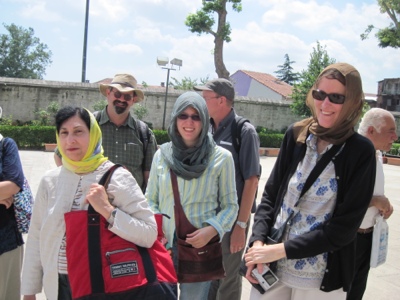The Blue Mosque was built from 1609-1616. This mosque was built by Sultan Suleyman. It includes both Byzantine and Islamic architecture. It was damaged by a fire in 1660 and later restored. The dome collapsed in an earthquake in 1766. It suffered damage in WWI because ammunition stored in the courtyard ignited. It was fully restored in 1956. There are two mausoleums with the remains of Sultans and some of their royal family members.
It was constructed on the site of several previous royal palaces that had to be pulled down in order for the construction to proceed. The palace foundations were used in places for the new mosque. There are 6 minarets, very unusual in the Muslim world.
Many people worship at the mosque, but Muslims do not have a particular worshiping community/mosque to which they formally belong (ie no "church membership").
There is a large inner courtyard outside the mosque entrance where people can worship when there is no more room inside. There is no amplification needed inside the mosque because of the accoustics, but outside they have two 'cantors' who repeat the Imam's message to those in the courtyard.
A chain hangs in the upper part of the courtyard entrance to the mosque. Only the Sultan could enter the courtyard on horseback and he had to duck to go under the chain, this symbolically ensured his humility before God.
The interior is lined with over 20,000 handmade ceramic tiles with 50 different tulip designs. There are 200 stained glass windows. The chandeliers once had ostrich eggs on them (supposed to repel spiders and avoid cobwebs). These have been pillaged over the years, or taken to museums. The tablets on the walls are inscribed with the names of caliphs and verses from the Quran.










No comments:
Post a Comment